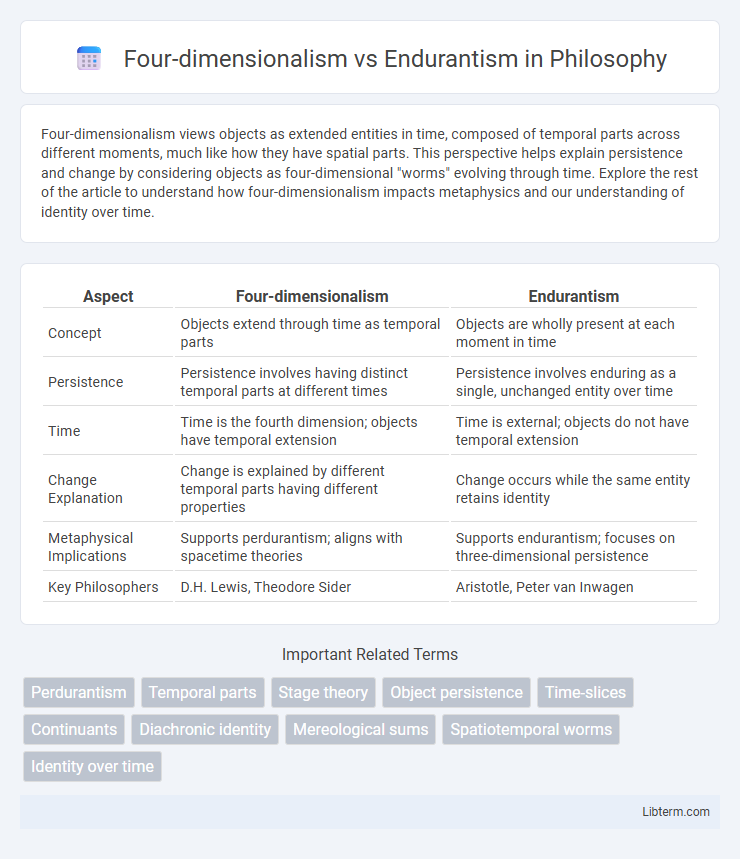Four-dimensionalism views objects as extended entities in time, composed of temporal parts across different moments, much like how they have spatial parts. This perspective helps explain persistence and change by considering objects as four-dimensional "worms" evolving through time. Explore the rest of the article to understand how four-dimensionalism impacts metaphysics and our understanding of identity over time.
Table of Comparison
| Aspect | Four-dimensionalism | Endurantism |
|---|---|---|
| Concept | Objects extend through time as temporal parts | Objects are wholly present at each moment in time |
| Persistence | Persistence involves having distinct temporal parts at different times | Persistence involves enduring as a single, unchanged entity over time |
| Time | Time is the fourth dimension; objects have temporal extension | Time is external; objects do not have temporal extension |
| Change Explanation | Change is explained by different temporal parts having different properties | Change occurs while the same entity retains identity |
| Metaphysical Implications | Supports perdurantism; aligns with spacetime theories | Supports endurantism; focuses on three-dimensional persistence |
| Key Philosophers | D.H. Lewis, Theodore Sider | Aristotle, Peter van Inwagen |
Introduction to Persistence in Metaphysics
Four-dimensionalism posits that objects persist through time by having temporal parts, treating time as an additional dimension akin to space. Endurantism maintains that objects are wholly present at every moment of their existence without temporal parts. This debate centers on how persistence and identity over time are metaphysically understood, influencing theories of change and temporal ontology.
Defining Four-dimensionalism
Four-dimensionalism posits that objects extend across time as well as space, existing as a series of temporal parts or stages that collectively form a complete entity. This metaphysical view contrasts with endurantism, which holds that objects are wholly present at each moment in time without temporal parts. By treating persistence as a temporal composition, four-dimensionalism offers a framework for understanding identity, change, and persistence through time.
Understanding Endurantism
Endurantism posits that objects are wholly present at every moment of their existence, maintaining their identity through time without temporal parts. It contrasts with four-dimensionalism, which views entities as extended in time and composed of temporal segments. This perspective supports a common-sense understanding of persistence, emphasizing continuous existence rather than fragmentation across temporal dimensions.
Historical Background and Key Philosophers
Four-dimensionalism, rooted in the philosophy of time and identity, gained prominence through the work of philosopher David Lewis, who argued that objects extend across time as temporal parts. Endurantism, with origins dating back to classical metaphysics and prominently defended by Aristotle, holds that objects are wholly present at every moment of their existence. Key debates between these views involve philosophers like J.J.C. Smart, who supported endurantism, and Theodore Sider, a contemporary proponent of four-dimensionalism, shaping ongoing discussions about persistence and temporal identity.
Ontological Commitments of Four-dimensionalism
Four-dimensionalism posits that objects extend across time as well as space, committing ontologically to temporal parts or stages that constitute the entirety of an object's existence. This view contrasts with endurantism, which maintains that objects are wholly present at every moment of their temporal existence without dividing into temporal parts. The ontological commitment of four-dimensionalism involves accepting a four-dimensional spacetime framework where persistence is understood through the aggregation of instantaneous temporal parts.
Ontological Commitments of Endurantism
Endurantism entails that objects are wholly present at every moment of their existence, committing ontologically to the persistence of entities as complete, enduring individuals through time. This view contrasts with four-dimensionalism, which posits entities extend across time with distinct temporal parts, thereby reducing ontological commitment to temporal segments. By emphasizing the indivisibility and continuous presence of objects, endurantism upholds a robust ontology of persistent substances existing wholly at each temporal stage.
Major Arguments for Four-dimensionalism
Four-dimensionalism argues that objects persist by having temporal parts spread across time, contrasting endurantism's view of wholly present objects at each moment. Major arguments for four-dimensionalism include its ability to resolve puzzles like the Ship of Theseus by treating identity as a series of temporal segments, preserving continuity without paradox. It also accounts for change more naturally, since different temporal parts can possess different properties without contradiction.
Major Arguments for Endurantism
Endurantism asserts that objects are wholly present at every moment of their existence, directly challenging the Four-dimensionalist view that objects extend through time as temporal parts. Major arguments for Endurantism emphasize the intuitive unity and persistence of objects, arguing this better accounts for ordinary experiences and everyday language about identity. Furthermore, Endurantism addresses puzzles of change by maintaining that the same object retains its identity despite undergoing different properties at different times.
Philosophical Implications and Contemporary Debates
Four-dimensionalism posits that objects extend through time as temporal parts, challenging traditional notions of persistence and raising questions about identity over time. Endurantism, by contrast, asserts that objects are wholly present at each moment, prompting debates on how change and temporal properties are accounted for philosophically. Contemporary discourse explores the implications of these views for metaphysics, particularly regarding the nature of time, existence, and objecthood in analytic philosophy.
Conclusion: Weighing Four-dimensionalism vs Endurantism
Four-dimensionalism offers a robust framework for understanding persistence through time by treating objects as extended entities with temporal parts, aligning well with theories in physics and metaphysics. Endurantism, emphasizing wholly present objects at each moment, provides intuitive appeal for everyday experiences and identity but struggles with temporal paradoxes. Weighing both, four-dimensionalism presents stronger explanatory power for temporal phenomena, while endurantism remains compelling for common-sense ontology.
Four-dimensionalism Infographic

 libterm.com
libterm.com